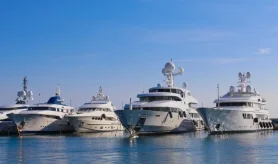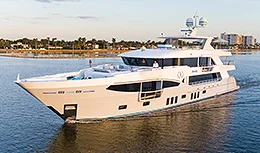- Alaskan Yachts
- Azimut Yachts
- Back Cove Yachts
- Beneteau Yachts
- Benetti Superyachts
- Bertram Yachts
- Boston Whaler
- Broward Yachts
- Buddy Davis Sportfish
- Burger Yachts
- Cabo Yachts
- Catamarans
- Carver Motoryachts
- Center Console
- Chris-Craft Yachts
- Cruisers Yachts
- DeFever Trawlers
- Dufour Sailboats
- Fairline Yachts
- Feadship Yachts
- Ferretti Yachts
- Filippetti Yachts
- Formula Yachts
- Fountaine Pajot Cats
- Grady-White
- Grand Banks Trawlers
- Hargrave Yachts
- Hatteras Yachts
- Hinckley Picnic Boats
- Horizon Yachts
- Hydra-Sports
- Intrepid Boats
- Jarrett Bay Sportfish
- Jeanneau Yachts
- Kadey-Krogen Trawlers
- Lazzara Yachts
- Lekker Boats
- Luhrs Sportfish
- Marlow Yachts
- Maritimo Yachts
- Marquis Yachts
- Mazu Yachts
- McKinna Motoryachts
- Meridian Yachts
- Midnight Express
- MJM Yachts
- Mochi Craft
- Neptunus Motoryachts
- Nordhavn Trawlers
- Nordic Tugs
- Numarine Yachts
- Ocean Alexander Yachts
- Ocean King
- Offshore Yachts
- Outer Reef
- Oyster Sailing Yachts
- Pacific Mariner Yachts
- Palmer Johnson Yachts

Denison History: Broward Marine Goes to War
The sleepy boatyard Frank Denison bought on his honeymoon in the late 1940s was soon to become the largest employer in Broward county, and the largest defense contractor in Florida.
This article was written by Marilyn Mower. Photography courtesy of Denison Yachting.
In 1939, Fort Lauderdale was a sleepy little vacation and fishing town with a population of about 20,000 working its way out of the Great Depression. Then one day, a British Navy destroyer providing coastal cover to ships supplying Britain’s war effort spotted a German tanker offshore and chased its enemy into Port Everglades. With the destroyer lurking offshore, the tanker was unable to leave, its presence making the locals ever mindful of the escalating war in Europe. Once the United States entered World War II, the US seized the ship and beefed up its military presence in Florida, which was a good thing, since the German tanker had not been the only Nazi vessel navigating Florida waters.
A deep-water harbor, Port Everglades was nearly adjacent to a civilian airport called Merle Fogg Field. Within weeks of the Japanese attack on Pearl Harbor, the government acquired the airfield. The Army Corps of Engineers immediately began transforming it into a Navy base and naval air station with much greater capacity than its base in Key West.
The gentle weather made it a perfect site to train Navy and Marine pilots, gunners, radio men, and air crews, as well as air-sea rescue teams. The Everglades provided a handy practice bombing range. Two satellite airstrips, now Fort Lauderdale Executive Airport and North Perry, became practice zones for landing and take-off and hands-on training for aircraft maintenance crews. Fogg Field soon grew to 200 buildings extending to the port. At its peak, the Fort Lauderdale Naval Air Station housed 3,000 personnel and based 200 aircraft. Among the Avenger torpedo bomber pilots trained there was Ensign George H. W. Bush.

Meanwhile, up the New River off 20th Street, Dooley’s Basin and Dry Dock, established in 1937 by Paul Dooley, ramped up from boat repair and small craft construction to build nearly 100 ships for the armed forces in WWII: two sub chasers, 48 harbor patrol boats, and 45 sea-air rescue craft, affectionately known as Crash Boats. With 300 employees, Dooley’s was Broward county’s largest civilian war-related business. Dooley had invested in infrastructure and had in place a 500-ton railway, a 50-ton lift, and a 40-ton crane.
The Crash Boats came in two sizes, 85- and 63-feet LOA. They had been designed by Dair Long and were built primarily of Honduras mahogany, spruce plywood, and oak. Interestingly, the hulls were double-planked mahogany, 3/4-inch on the bottom and 9/16s on the hull sides. Eight-ounce cotton duck fabric, saturated with marine/aviation glue was sandwiched between the two layers.
After VJ in 1945, orders for military boats slowed to a trickle and then stopped. For Paul Dooley, the war had been good business. However, hurricanes slammed Fort Lauderdale in September and October in 1947, and Dooley began to think enough was enough. By 1948, he let it be known that his yard was for sale.
Enter Frank Denison from Michigan, his bride, Gertrude, in tow.
They came to Fort Lauderdale to honeymoon and Frank, who had recently sold his trucking business, was looking for a new venture. Denison knew little about boats but had worked on diesel engine repair and replacement, which along the way included a few boats, one of which, it so happened, was at Dooley’s Basin. When he learned it was for sale, he renewed acquaintances.
The Denisons bought the yard and renamed it Broward Marine. It remained merely a repair yard until the US Navy found itself rather spectacularly unprepared for the Korean War. At the close of WWII, the government sold off or mothballed most of its minesweepers and focused its interest and its budget on developing the next generation of aircraft carriers. Most of its remaining minesweeping fleet had been transferred to the Atlantic in support of NATO. When President Truman entered the US Armed Forces into the conflict for the United Nations Blockade and Escort Force, there were four 180-foot steel-hull minesweepers and six wooden auxiliary minesweepers in the entire Pacific.
As the commanders mapped out their strategy, it became clear that the only way to get troops and supplies into the peninsula would be by sea. Unfortunately, the Communist-backed North had already mined the harbors and sea lane approach routes with an estimated 3,000 mines. It even mined its own ports with magnetic German mines the Russians had liberated from the Nazis after Germany’s surrender.
In 1951, Truman ordered Mine Squadron 3 to Korea; these ships were totally outmatched in the unknown waters and the magnetic mines spelled disaster for the steel ships. Not only were the Soviets teaching their mine warfare techniques to the North Koreans, but their Navy had been building wooden minesweepers and minelayers non-stop since 1945.
Mines Caused 70 Percent of All United States Naval Casualties During the First Two Years of The 37-Month War.
UN Forces planned a huge attack they hoped would be a preemptive strike at an area called Wonsan. Thousands of troops lay offshore on 200 ships ready to follow the minesweepers in for a full-scale invasion. It was a failure. The tally mounted quickly: eight destroyers severely damaged; eight minesweepers and one ocean tug sunk. The invasion force retreated while the commanders began to learn the scope of the North Korean mine defenses.
Navy flying boats, helicopters, and underwater demolition swimmer teams worked non-stop charting mines, followed by the remaining handful of minesweepers clearing them, only to have them reappear overnight deployed by inconspicuous sampans and fishing junks. To make matters worse, the North Koreans were using an assortment of mines, some as old as 1904 contact mines, some magnetic and some pressure sensitive. Each type needed a different tactic. It was slow going.

Rear Admiral Allan E. Smith cabled the war office: “We have lost control of the seas to a nation without a Navy, using pre-World War I weapons, laid by vessels that were utilized at the time of the birth of Christ.”
The Administration got the message. In late 1950, the Navy hired naval architect Philip Rhodes to design new wooden minesweepers that could adapt to new sweeping techniques. The result was the 172-foot, 630-ton Aggressive Class Ocean minesweeper. It used a non-magnetic engine, wood hull construction, and an improved mine-hunting sonar.
Because they were needed yesterday, the bids for new minesweepers went to just about any available US yard, 27 in fact. Because Dooley’s had been a contractor for wooden boats in WWII, Broward Marine received a request for a proposal. Denison knew nothing about building Navy ships, but he understood production. Of Dooley’s original military workforce, only about 20 remained, but that was enough to form a core group of trainer/shipwrights. Gertrude herself typed up the bid and they delivered it to Washington. In short order, the Navy handed Broward an order for four Aggressive Class ships as well as three 144-foot Falcon Class and four 144-foot Adjutant Class coastal sweepers from an earlier design. It was a great haul for the yard.
The exact scantlings were lost in the 1996 Broward Marine fire, but some Navy documents and documentation of a lengthy restoration one Adjutant Class sweeper built at Tacoma Boat Works indicate that the boats were mostly fir or spruce planking with red or white oak to provide high underwater shock and impact loading for transverse frames and knees, southern pine for butt blocks, Alaska yellow cedar for interior diagonal planking and superstructure sills, southern pine over tarred felt for worm sheathing, and Douglas fir plywood for structural members and decks.
For Broward Marine, there were just two problems. All of the boats had a draft of nine feet or more and the South Fork of the New River was less deep than that in several spots. Plus, they were too long to be launched via the slipway; Dooley’s WWII boats had been half that long.
Denison was undaunted. He would launch the hulls sideways—hell of a splash but without their superstructures in place, they just bobbed up like corks! As for the new river, towed them to a rented facility in Port Everglades and there installed the engines, decks, superstructures, equipment, and guns. To stay on schedule, one of the 144-footers had to launch every 45 days and one of the 172s every 90 days. It was nearly insane. The local workforce swelled with men who had wartime experience at other shipyards and were happy to relocate to Florida. Gertrude, Frank, and their young sons moved to an apartment above the construction floor to supervise. The first minesweeper was was delivered October 1952. Before long, they were the largest employer in Broward Country and the largest defense contractor in Florida. All of the Broward minesweepers survived the Korean War and many went on to serve the Navy in Vietnam as well. By then, Broward was well on its way to becoming a world-class builder of aluminum yachts.

Request A Copy
Special Thanks to Our Partners








